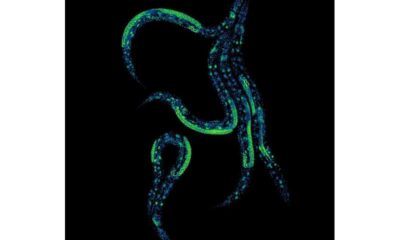Science
New Study Links Gene Location to Natural Selection in Copepods

A recent study by researchers at the University of Wisconsin-Madison has established a crucial connection between gene location and natural selection, demonstrating that the arrangement of genes can significantly influence how quickly populations adapt to rapid environmental changes. Published on November 24, 2025, in the journal Nature Communications, the research examined the genomes of three sibling species of copepods known as the Eurytemora affinis species complex.
The study revealed that specific mutations, termed chromosomal fusions, have altered the positioning of genes as these tiny aquatic crustaceans evolved. The research team discovered that despite these fusions occurring millions of years ago, they continue to impact the adaptability of contemporary species.
Historically, these copepods primarily inhabited coastal estuarine ecosystems. However, in recent decades, they have invaded freshwater environments, including the Great Lakes, largely due to the transport and disposal of ship ballast water.
Decoding Copepod Genetics
Professor Carol Eunmi Lee, who has dedicated over 20 years to studying copepod genetics, emphasizes the importance of understanding how these organisms adapt to their new habitats. The short lifespan and relatively small genomes of copepods make them ideal subjects for such investigations. It took postdoctoral researcher Zhenyong Du nearly three years to sequence the genomes and analyze how chromosomal fusions have repositioned genes, uncovering patterns indicative of natural selection.
The study’s findings were unexpected. Each of the three sibling species exhibited different chromosome counts: the European clade has 15 chromosomes, the Gulf clade has seven, and the Atlantic clade, now residing in the Great Lakes, possesses only four. This variance is unusual among species with differing chromosome numbers, as they typically cannot interbreed.
Du expressed surprise at these results, noting the rarity of interbreeding among organisms with different chromosomal structures. The team set out to investigate the evolutionary reasons behind this genetic diversity.
Chromosomal Fusions and Adaptation Mechanisms
The researchers examined the evolutionary history of the chromosomes and found that chromosomal fusions, which involve the merging of different chromosomes, are frequent mutations. This process can unite genes from separate chromosomes, potentially forming units of inheritance that are subject to natural selection.
Du and Lee hypothesized that the fusions leading to distinct chromosome numbers might have conferred survival advantages in the past. Salinity has historically been a critical factor for copepods, influencing their living conditions. The study identified that one of the primary mechanisms copepods use to adapt to salinity changes involves proteins known as ion transporters. The ancient chromosomal fusions resulted in key ion transporter genes being clustered together, which is crucial for the copepods’ survival in varying salinity levels.
Interestingly, the research also indicated that these gene groupings migrated away from the ends of chromosomes, which are areas prone to recombination, and toward the center, where combinations of beneficial gene variants remain intact. Recombination, a natural process during reproduction, fosters genetic diversity, which can enhance a species’ chances of survival.
The implications of this study extend beyond copepods. According to Du and Lee, the evidence linking genomic architecture evolution, particularly chromosomal fusions, to adaptive processes may influence how scientists approach genetic adaptation in other invasive species. This research could also provide insights into predicting which populations are more likely to survive and adapt to future climate changes.
Lee concluded that the architecture of genomes significantly impacts how populations respond to natural selection, affecting the mechanisms of evolution and the speed at which species can adapt.
For further details, the full study can be found in Nature Communications, DOI: 10.1038/s41467-025-65292-z.
-

 Technology5 months ago
Technology5 months agoDiscover the Top 10 Calorie Counting Apps of 2025
-

 Technology3 weeks ago
Technology3 weeks agoOpenAI to Implement Age Verification for ChatGPT by December 2025
-

 Health3 months ago
Health3 months agoBella Hadid Shares Health Update After Treatment for Lyme Disease
-

 Health3 months ago
Health3 months agoAnalysts Project Stronger Growth for Apple’s iPhone 17 Lineup
-

 Health3 months ago
Health3 months agoErin Bates Shares Recovery Update Following Sepsis Complications
-

 Technology5 months ago
Technology5 months agoDiscover How to Reverse Image Search Using ChatGPT Effortlessly
-

 Technology3 months ago
Technology3 months agoElectric Moto Influencer Surronster Arrested in Tijuana
-

 Technology2 months ago
Technology2 months agoDiscover 2025’s Top GPUs for Exceptional 4K Gaming Performance
-

 Technology5 months ago
Technology5 months agoMeta Initiates $60B AI Data Center Expansion, Starting in Ohio
-

 Technology5 months ago
Technology5 months agoRecovering a Suspended TikTok Account: A Step-by-Step Guide
-

 Health5 months ago
Health5 months agoTested: Rab Firewall Mountain Jacket Survives Harsh Conditions
-

 Lifestyle5 months ago
Lifestyle5 months agoBelton Family Reunites After Daughter Survives Hill Country Floods





















